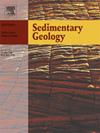The migration pattern of oxidation fluids and its constraints on uranium mineralization in the Tamusu sandstone type uranium deposit of the Bayingobi Basin, China
IF 2.9
2区 地球科学
Q1 GEOLOGY
引用次数: 0
Abstract
Exploring the developmental stages and migration patterns of oxidation zones has always been a key task in the exploration of sandstone uranium deposits, but the involvement of deep fluid activity often makes it difficult to determine the characteristics of oxidizing fluids. The Tamusu deposit is a large sandstone-host uranium deposit, characterized of large scale oxidation zone, multiple layers of ore bodies, dense sandstone, and obvious hydrothermal alteration. However, the stage and mechanism of the occurrence of oxidative fluids are still unclear. Identifying the stages and migration patterns of oxidizing fluids and determining their relationship with uranium enrichment are of great significance for revealing the genesis of mineral deposits and exploring uranium deposits in other similar basins. In this study, core observation, microscopy, electron probe, scanning electron microscopy, cathodoluminescence, and α track etching were used to study the distribution of oxidation zones, the formation sequence of altered minerals, and uranium mineralogical characteristics. The oxidation zone occurs on a large scale in the upper member of the fan delta sand body, with almost all disappeared at the interface between sandstone and mudstone, and the oxidation fluid migration also occurs in many fractures of the target layer. The altered minerals in the Tamusu deposit mainly include hematite, limonite, dolomite, ankerite, gypsum, pyrite, and other metal sulfides. The uranium minerals in the ore are mainly pitchblende, some coffinite and U![]() Ti mixture,with a small amount of secondary uranium minerals. Uranium minerals are mainly distributed on the surface of debris particles, around pyrite or carbon debris, as well as in dissolution pores or growth zones of ankerite. The sedimentation and alteration of Tamusu sandstone can be divided into 4 stages: sedimentation to early diagenesis stage, early large-scale oxidation stage, thermal fluid alteration stage, and late weak oxidation stage. The sandstone with excellent pores in the early diagenetic stage and the unobstructed groundwater recharge, runoff, and drainage system are the main reasons for the formation of large-scale oxidation. At the end of the Early Cretaceous, hydrothermal activity formed a large amount of dolomite, ankerite, gypsum, etc., which solidified the sandstone and terminated the migration of oxidizing fluids in the pores of the sandstone. After the consolidation of sandstone, the oxidized fluid mainly migrated along the fractures in the formation, or also transformed some early consolidated sand bodies near the edge of the basin, and the oxidation scale significantly weakened. Therefore, the Tamusu deposit experienced three main stages: Large scale oxidation and low-grade U formation stage,hydrothermal alteration and U mineralization and late oxidation weak uranium mineralization stage.
Ti mixture,with a small amount of secondary uranium minerals. Uranium minerals are mainly distributed on the surface of debris particles, around pyrite or carbon debris, as well as in dissolution pores or growth zones of ankerite. The sedimentation and alteration of Tamusu sandstone can be divided into 4 stages: sedimentation to early diagenesis stage, early large-scale oxidation stage, thermal fluid alteration stage, and late weak oxidation stage. The sandstone with excellent pores in the early diagenetic stage and the unobstructed groundwater recharge, runoff, and drainage system are the main reasons for the formation of large-scale oxidation. At the end of the Early Cretaceous, hydrothermal activity formed a large amount of dolomite, ankerite, gypsum, etc., which solidified the sandstone and terminated the migration of oxidizing fluids in the pores of the sandstone. After the consolidation of sandstone, the oxidized fluid mainly migrated along the fractures in the formation, or also transformed some early consolidated sand bodies near the edge of the basin, and the oxidation scale significantly weakened. Therefore, the Tamusu deposit experienced three main stages: Large scale oxidation and low-grade U formation stage,hydrothermal alteration and U mineralization and late oxidation weak uranium mineralization stage.

巴音郭壁盆地塔木苏砂岩型铀矿床氧化流体运移模式及其对铀矿化的制约
研究氧化带的发育阶段和运移模式一直是砂岩铀矿床勘探的重要任务,但深部流体活动的参与往往给氧化流体特征的确定带来困难。塔木苏矿床为大型砂岩型铀矿床,具有氧化带规模大、矿体层数多、砂岩致密、热液蚀变明显等特点。然而,氧化流体发生的阶段和机制尚不清楚。识别氧化流体的阶段和运移模式,确定其与铀富集的关系,对揭示矿床成因和在其他类似盆地寻找铀矿具有重要意义。采用岩心观察、显微观察、电子探针、扫描电镜、阴极发光、α径迹刻蚀等方法研究了氧化带的分布、蚀变矿物的形成顺序及铀矿学特征。氧化带在扇三角洲砂体上段大规模出现,在砂泥岩界面处几乎全部消失,氧化流体运移也发生在目标层的多处裂缝中。塔木苏矿床蚀变矿物主要有赤铁矿、褐铁矿、白云石、铁白云石、石膏、黄铁矿等金属硫化物。矿石中铀矿物以沥青铀矿为主,部分为铀矿石和UTi混合物,含少量次生铀矿物。铀矿物主要分布在岩屑颗粒表面、黄铁矿或碳屑周围以及铁白云石的溶蚀孔或生长带中。塔木苏砂岩沉积蚀变可分为沉积—早期成岩阶段、早期大规模氧化阶段、热流体蚀变阶段和晚期弱氧化阶段4个阶段。早期成岩阶段孔隙良好的砂岩和地下水补给、径流、排水系统的畅通是形成大规模氧化的主要原因。早白垩世末期,热液活动形成了大量白云岩、铁白云岩、石膏等,使砂岩凝固,并终止了氧化流体在砂岩孔隙中的运移。砂岩固结后,氧化流体主要沿地层裂缝运移,或对盆地边缘部分早期固结砂体进行改造,氧化规模明显减弱。因此,塔木苏矿床经历了3个主要阶段:大规模氧化低品位铀形成阶段、热液蚀变铀成矿阶段和晚期氧化弱铀矿化阶段。
本文章由计算机程序翻译,如有差异,请以英文原文为准。
求助全文
约1分钟内获得全文
求助全文
来源期刊

Sedimentary Geology
地学-地质学
CiteScore
5.10
自引率
7.10%
发文量
133
审稿时长
32 days
期刊介绍:
Sedimentary Geology is a journal that rapidly publishes high quality, original research and review papers that cover all aspects of sediments and sedimentary rocks at all spatial and temporal scales. Submitted papers must make a significant contribution to the field of study and must place the research in a broad context, so that it is of interest to the diverse, international readership of the journal. Papers that are largely descriptive in nature, of limited scope or local geographical significance, or based on limited data will not be considered for publication.
 求助内容:
求助内容: 应助结果提醒方式:
应助结果提醒方式:


